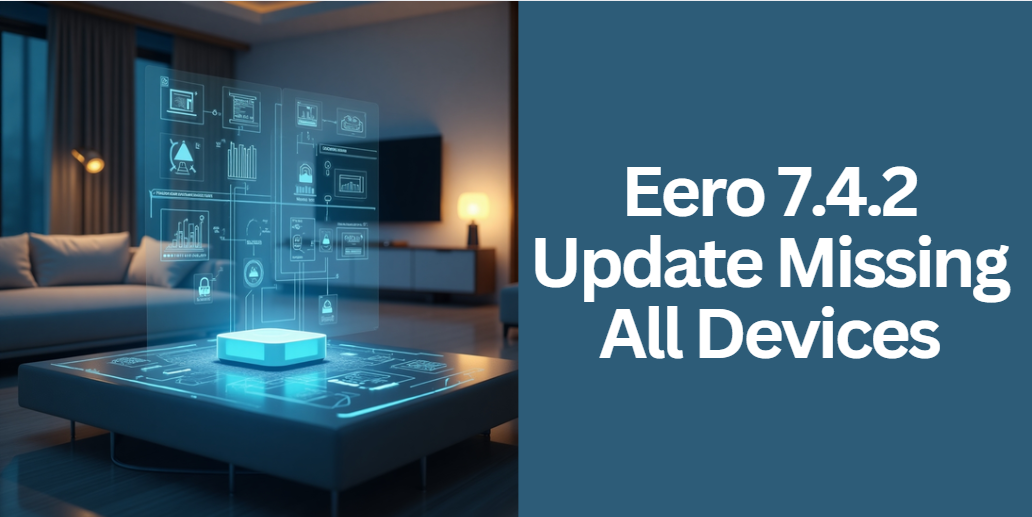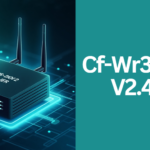The Eero 7.4.2 Update Missing All Devices issue has generated significant concern among users, as many report that connected devices vanish from the Eero app after the update is applied. This comprehensive guide explores the background of Eero firmware updates, explains the possible causes behind the missing device phenomenon, and offers detailed troubleshooting methods.
Our aim is to provide clear guidance that addresses network management, security, and performance challenges, ensuring you maintain complete control over your network.
Background and Context
Eero firmware updates are designed to enhance performance, stability, and security. The update process itself is sophisticated and typically follows a phased rollout strategy. This approach means that not all devices receive the update simultaneously, which can sometimes result in inconsistencies.
In the case of the Eero 7.4.2 Update Missing All Devices issue, the update intended to deliver performance improvements and tighten security; however, some users experienced a breakdown in device visibility within the app.
Understanding Eero’s phased rollout strategy is crucial. It explains why some nodes might still run an older version of the firmware, causing irregularities in device reporting. Additionally, Eero integrates with other smart home services like Amazon Alexa, and any misalignment in these integrations can further complicate the update process.
Understanding the Missing Devices Problem
After the 7.4.2 update, many users have found that devices connected to their network suddenly disappear from the Eero app. Although these devices remain online and functional, the absence in the management interface disrupts effective monitoring and troubleshooting.
Real-life reports from community forums and user testimonials illustrate a consistent pattern of issues that range from incomplete firmware installation to unexpected software glitches.
For example, one user described how the app no longer displayed his smart home devices after the update, leaving him unable to manage network security settings. Another user noted that his performance monitoring tools were disrupted, leading to slower speeds and connectivity problems. Such instances underscore the real-world impact of the Eero 7.4.2 Update Missing All Devices issue on everyday network management and security.
In-Depth Analysis: Causes and Contributing Factors
Several factors contribute to this issue. One primary cause is the possibility of an incomplete firmware installation due to the phased update process. When some Eero nodes lag behind, inconsistencies in device visibility can occur.
Another factor is network configuration conflicts. Many advanced users customize settings such as DNS configurations, VPNs, or firewall rules, which might interfere with the update process. The update can sometimes override these settings, leading to discrepancies in how connected devices are recognized by the system.
Additionally, integration issues with third-party services like Amazon Alexa may lead to device syncing errors. These errors can prevent the Eero app from accurately displaying connected devices, even if they are functioning correctly. Lastly, there is always the possibility of inherent software glitches or device compatibility issues, especially when new firmware versions introduce changes that older hardware struggles to support.
Causes Table
| Cause | Description |
|---|---|
| Incomplete Firmware Installation | Phased rollouts may leave some devices on an older version, causing inconsistencies in reporting connected devices. |
| Network Configuration Conflicts | Custom settings such as VPNs, DNS configurations, or firewall rules might interfere with the update, resulting in missing devices. |
| Third-Party Integration Issues | Misalignment or syncing issues with services like Amazon Alexa can lead to device visibility problems within the Eero app. |
| Software Glitches/Compatibility Issues | New firmware may introduce bugs or be incompatible with older devices, affecting the system’s ability to properly display all connected devices. |
Step-by-Step Troubleshooting Guide
To help users resolve the Eero 7.4.2 Update Missing All Devices issue, follow these detailed troubleshooting steps:
Diagnostic and Initial Steps
Begin by confirming your firmware version through the Eero app. Ensure that your network is functioning normally, even if devices are not being displayed correctly. Verifying the current firmware version will help determine if your network is partially updated or if further intervention is needed.
Power Cycling Your Network
A common and effective troubleshooting method is to perform a power cycle. Unplug your Eero devices and modem from the power outlet for at least 30 seconds. After waiting, plug the modem back in and then reconnect the Eero devices. This simple restart often forces devices to re-establish connections and may prompt the update process to complete properly.
Manually Forcing the Update
If power cycling does not resolve the issue, open the Eero app and navigate to the Settings section. Look for the Software Update area and manually initiate the update if an option is available. This step can trigger the update to reinstall or continue where it left off, ensuring all nodes are synchronized.
Verifying and Adjusting Network Settings
Advanced network configurations can sometimes interfere with firmware updates. It is advisable to review any custom DNS settings, VPN connections, or firewall rules that you have implemented. Temporarily reverting these settings to their defaults can help identify if they are contributing to the problem. Once the update is completed, you can reapply your custom configurations.
Checking Third-Party Integrations
If you have integrated your Eero system with services like Amazon Alexa, ensure that account syncing is working correctly. Disconnect and then re-establish the integration if necessary. This step can resolve issues where third-party services are causing device visibility errors.
Advanced Troubleshooting and Factory Reset
In cases where none of the above solutions work, consider performing a factory reset on your Eero devices. This should be used as a last resort since it will erase all your current settings. Before proceeding, back up your network configuration details. A factory reset forces all devices to return to default settings and then reconnect, often clearing any lingering software conflicts.
Contacting Eero Support
If the issue persists even after exhaustive troubleshooting, it is essential to contact Eero support. Prepare a detailed report that includes your firmware version, network configuration, and any troubleshooting steps you have already attempted. Eero’s support team can then provide targeted assistance to resolve the Eero 7.4.2 Update Missing All Devices problem.
Preventative Measures and Best Practices
To avoid encountering similar issues in the future, regular maintenance and vigilance are key. Ensure that your Eero devices are always connected to the internet and receive updates automatically. Maintaining default network settings, especially if you are not an advanced user, can prevent configuration conflicts. It is also advisable to periodically check for firmware updates manually, even if you have automatic updates enabled.
A sample checklist for preventative measures could be organized in a table:
| Preventative Measure | Recommendation |
|---|---|
| Automatic Firmware Updates | Enable and verify automatic updates in the Eero app regularly to ensure all devices stay current. |
| Default Network Configurations | Use default settings unless advanced customization is required. |
| Regular Network Monitoring | Schedule periodic checks of the device list in the Eero app to confirm that all devices are visible and operational. |
| Third-Party Service Synchronization | Regularly verify integrations with services like Amazon Alexa to avoid syncing errors. |
Impact on Network Security and Performance
Missing devices in your network management app can have significant repercussions. From a security perspective, the inability to monitor every device leaves potential vulnerabilities unchecked. Network performance may also suffer if updates remain incomplete, as critical performance and stability improvements are not fully implemented.
Long-term, consistently missing updates can lead to slower speeds and a higher risk of security breaches. It is important to stay proactive with updates to maintain the integrity of your network and the safety of your connected devices.
Case Studies and Real-Life User Experiences
Real-world examples help illustrate the challenges and solutions associated with the Eero 7.4.2 Update Missing All Devices issue. One user recounted how repeated power cycles and manual updates eventually restored his network’s full functionality.
Another described how resetting third-party integrations resolved visibility issues. Comparing these experiences with previous firmware updates shows that while the 7.4.2 update brought significant improvements, it also highlighted vulnerabilities that can affect user experience.
Below is an example of how a case study might be formatted:
| User Experience | Challenge Encountered | Resolution Implemented | Outcome |
|---|---|---|---|
| Home Office Network | Devices missing after firmware update | Power cycle, manual update, and checking settings | Device list restored; network performance improved |
| Smart Home Integration | Alexa integration error causing missing devices | Re-syncing Amazon Alexa with Eero system | All devices displayed; smart home functionality normalized |
Expert Opinions and Recommendations
Leading network experts suggest that while firmware updates are essential for maintaining security, they can occasionally introduce unforeseen complications. Interviews with IT professionals emphasize that regular monitoring, proper configuration, and timely troubleshooting are critical. Experts also recommend that users document their network settings before any major update, ensuring that recovery options are readily available.
In a recent expert review, a network specialist mentioned, “Ensuring that your network settings remain as close to the default as possible can mitigate many update-related issues. The key is consistency and proactive monitoring.” Such insights further underscore the importance of maintaining a stable and well-documented network environment.
Frequently Asked Questions (FAQs)
Are There Temporary Workarounds to Restore Device Visibility Without a Full Factory Reset?
Yes, some users have found that altering network settings temporarily—such as changing the Wi-Fi channel or modifying DNS settings—can help force a re-sync of connected devices. These adjustments can provide temporary relief while awaiting a more permanent firmware fix from Eero.
What Other Network Symptoms Might Indicate an Update Issue?
Beyond missing devices, some users report erratic connection speeds, intermittent drops in connectivity, or delayed responses in network management apps. These symptoms can serve as early warning signs that the update process has not completed correctly.
How Can I Determine if the Problem Is Firmware-Related Rather Than a Hardware Issue?
An effective way to differentiate is by comparing the behavior of devices on different firmware versions. If your network was stable before the update and issues started immediately afterward, it’s likely a firmware problem. Running diagnostic tests or connecting a backup Eero unit can help clarify whether hardware malfunction is a contributing factor.
Does the 7.4.2 Update Impact All Eero Models Equally?
Not necessarily. Some reports indicate that older models or devices with previous firmware versions may experience more pronounced issues than the latest models. Differences in hardware capabilities might cause varied responses to the same firmware update.
How Long Should I Wait for a Fix if I’ve Contacted Eero Support?
Response times can vary depending on the complexity of the issue and current support loads. Some users have reported resolution within a few days, while others may experience longer waiting times if further testing or a patch is required. Monitoring official communication channels for updates is a good practice.
Conclusion
In summary, the Eero 7.4.2 Update Missing All Devices issue can be challenging but is manageable with a systematic approach. We explored the causes—from phased rollouts and configuration conflicts to third-party integration errors—and provided a detailed troubleshooting guide. B
y following best practices, monitoring your network closely, and utilizing expert tips, you can ensure your Eero network remains secure and fully functional. Stay proactive and regularly update your devices to enjoy optimal performance and peace of mind.
This guide aims to be your one-stop resource for understanding and resolving the issues associated with the Eero 7.4.2 update, empowering you to take control of your network and maintain a robust, secure environment.
More Posts
Ultimate Guide to Cf-Wr302sv2-V2.4.0.1: Comprehensive Update & Optimization for Wireless Networks
Comprehensive Guide to 1-582-333-2096
Ultimate Guide to Nvvbik Fits Milwaukee 48-40-0625 6-1/2
Comprehensive Guide to the Connector Yazaki 7283-8497-90 2P 1.5 2P 9.5 WP Hybrid


